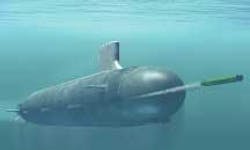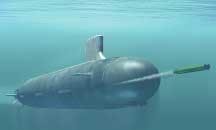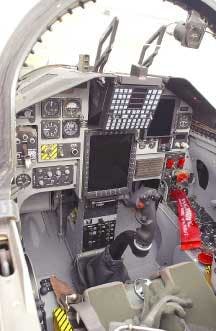Product Applications
Spotlight
Navy submarines use displays from DRS and Lockheed Martin
Planners at the U.S. Navy needed a display and processing station for submarine crewmembers to perform combat and acoustic tasks. They found a solution in the Advanced Display System from Lockheed Martin Corp. of Bethesda, Md., and DRS Technologies Inc. in Parsippany, N.J.
In November, those companies delivered the AN/UYQ-70 (Q-70) Enhanced Control Display Work Station (ECDWS). Sailors use the ECDWS for enhanced, real-time processing, secure target detection and analysis, and target motion, and situation analysis, all on one console.
“Lockheed Martin continues to provide leading-edge, quality Q-70 systems that act as the guiding intelligence of our weapons and acoustic systems infrastructure,” says Rear Adm. John Butler, the Navy’s program executive officer for submarines. “The Q-70 systems are extremely flexible and perform flawlessly under extreme environmental conditions. These technologies give us a crucial edge in safeguarding the nation we are honored to protect.”
The Lockheed Martin-DRS team has been supporting the Q-70 program since 1994, and is delivering the ECDWS units as an upgrade under the Acoustic Rapid COTS Insertion (ARCI) program. This program provides common sonar systems within an open-systems architecture that exploits commercial computing technology.
Q-70 workstations and systems currently are installed onboard Virginia-, Seawolf-, Los Angeles-, and Ohio-class submarines, Aegis-equipped cruisers and destroyers, aircraft carriers amphibious assault ships, the E-2C Hawkeye aircraft, and ground mobile units. For more information, see www.drs.com or www.lockheedmartin.com.
Displays
British air tankers will use Honeywell displays
Engineers at Marshall Aerospace, in Cambridge, England, needed computer displays to show radar results aboard British airborne tankers. They found a solution with the aerospace division of Honeywell International in Phoenix.
Honeywell technicians will make multifunction radar displays for nine L1011 TriStar tanker aircraft for the United Kingdom. Airmen will use the display to control the RDR-4B weather radar, eliminating the need for a separate control panel and independent displays for primary functions.
“Honeywell’s Multifunction Radar Display provides interfaces for multiple radar systems - Honeywell systems and older radar systems that include the Bendix APS-133 and RDR-1E/F,” says Joe Longworth, director of government sales for Honeywell Defense & Space Systems. “This system provides weather radar, Enhanced Traffic Collision Avoidance System (ETCAS) and Enhanced Ground Proximity Warning System (EGPWS) display, along with a navigation overlay.”
Deliveries will begin this year and be completed in 2005. For more information, see www.honeywell.com.
Components
Raytheon uses Saft battery in TOW missile
Engineers at Raytheon Co. in Waltham, Mass., needed a battery for the U.S. Army’s TOW missile. They found a solution with Saft in Cockeysville, Md.
Raytheon designers will use the lithium-ion batteries in the Improved Target Acquisition System (ITAS) of the tube-Launched, optically tracked, wire-guided (TOW) missile.
Saft has shipped the batteries to the 172nd Brigade at Fort Wainwright, Alaska. The U.S. Army’s Close Combat Weapons Systems Office at Redstone Arsenal in Huntsville, Ala., manages the program
“Saft’s lithium-ion batteries’ improved performance will enable the U.S. Army to realize a multimillion dollar life-cycle cost savings over the previously installed silver-zinc battery,” says Glen Bowling, director of defense sales at Saft’s Space and Defense Division in Cockeysville, Md. “In addition, the batteries meet a demanding MIS-PRF specification and provide a reliable, long life power source for the Army’s Improved Target Acquisition System.”
Carried in an HMMWV, the TOW ITAS is designed to defeat armored vehicles at extended ranges and provide a long-range surveillance system for the light infantry in all battlefield conditions. The ITAS consists of an integrated (day/night sight with laser rangefinder) target-acquisition subsystem, fire-control subsystem, lithium battery power source, and modified traversing unit. For more information, see www.saftbatteries.com.
Integrated circuits
Navy mine disposal vehicle uses Actel processor
Engineers at BAE Systems needed a processor for their mine disposal system. They found a solution with Actel Corp. in Mountain View, Calif.
BAE planners will use Actel’s Axcelerator field-programmable gate arrays (FPGAs) in their Archerfish Naval Mine Disposal System. They will use the antifuse-based AX250 device as a tamper-proof, radiation-resistant solution within the Archerfish’s safety and arming system.
The Archerfish is deployed from a helicopter or ship. The launch platform lowers a pod, which releases a small, maneuverable, one-shot mine disposal vehicle containing a warhead. Technicians guide the vehicle with sonar and remote camera as they seek sea mines to destroy.
“We needed a highly reliable programmable logic device that could be used in the fusing subsystem of Archerfish,” says Doug Green, senior design engineer at BAE Systems. “For obvious reasons this is a safety-critical application. Actel’s devices offered us a nonvolatile, one-time-programmable solution at a significantly lower cost than the ASIC alternative. In addition, we wanted the flexibility offered by an FPGA and wanted to eliminate the lengthy fabrication delays associated with ASICs.”
The Axcelerator AX250 device is part of the serial communications link between the pod and the weapon itself, which moves over a fiber optic cable. For more information, see www.actel.com.
Software
Navy picks Lockheed Martin software for submarines
Engineers at the U.S. Navy needed software for the Seawolf submarine radio room. They found a solution with Lockheed Martin, Bethesda, Md.
Navy planners named Lockheed Martin the Common Submarine Radio Room (CSRR) Software Design Agent and Interim Software Support Agent (SSA) for the Seawolf Class submarine.
Lockheed Martin will now provide CSRR solutions for the Ohio-, Virginia-, and Seawolf-class submarines. The CSRR upgrade contract is worth a potential $20 million over the next two to five years.
The CSRR program is the Navy’s communication bridge to common radio room systems across submarines and surface ships. CSRR provides an interoperable subsurface communication system using technology refresh and commonality transferable to surface shipboard systems.
“Extending the common submarine radio-room technologies and open-system architecture leverages the Navy’s investment in warship external communications,” says Captain Frank Unetic of the U.S. Navy’s Program Executive Office for Command, Control, Communications, Computers, Intelligence, and Space. “The CSRR approach allows the Navy to realize the benefits of common requirements, common architecture, common components, and gateway services that provide a bridge between the ship and joint offboard networks.”
CSRR reduces the area of a submarine’s radio room by 30 percent and watch stander manning by two- thirds, compared to earlier systems. The Los Angeles-class submarine is next in line for this transformational update.


